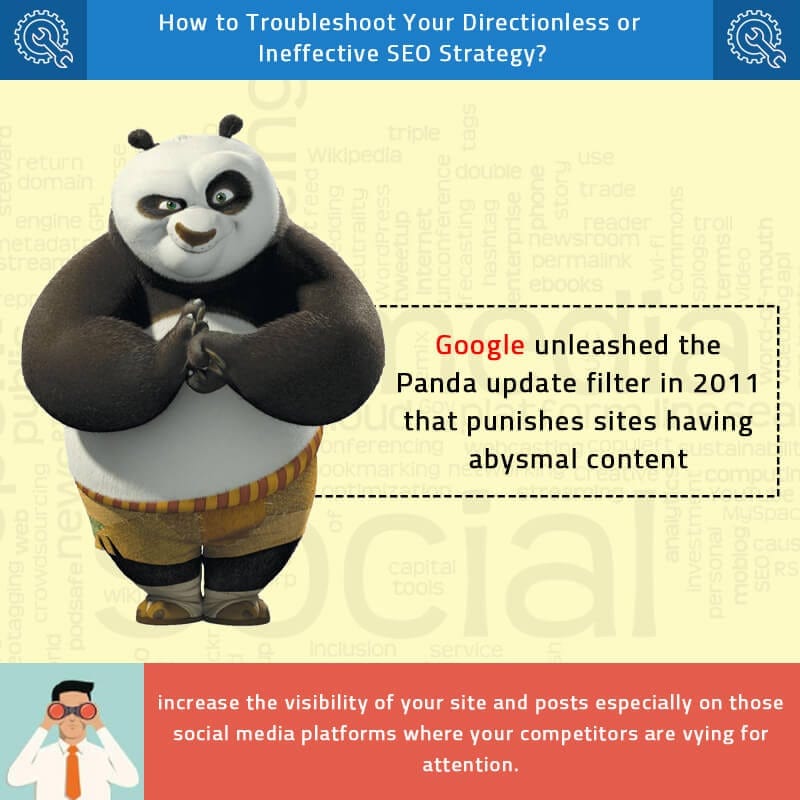 Despite your diligent and relentless efforts in devising an effective SEO strategy, you’re simply clueless about your approach backfiring. You agonize over your site’s poor SERP ranking and helplessly watch your competitors’ portals routinely climb the ranking ladder. Don’t you think it’s high time you did some serious introspection as to why you routinely come a cropper on your search engine optimization techniques? Following are six good reasons why most SEO drives fail complete with the remedial steps you need to take.
Despite your diligent and relentless efforts in devising an effective SEO strategy, you’re simply clueless about your approach backfiring. You agonize over your site’s poor SERP ranking and helplessly watch your competitors’ portals routinely climb the ranking ladder. Don’t you think it’s high time you did some serious introspection as to why you routinely come a cropper on your search engine optimization techniques? Following are six good reasons why most SEO drives fail complete with the remedial steps you need to take.
Can’t see the woods for the trees
There are so many institutions and individuals that remain aplomb in posting blunt or shallow content with high keyword density. These outfits are overconfident that using appropriate keywords and in large numbers will do the trick. Unfortunately for them, Google unleashed the Panda update filter in 2011 that punishes sites having abysmal content by relegating the rank of these portals. Always orientate your content around a subject-matter or topic and thereafter integrate the keywords with the content.
Content is shorter than it should be
If the Searchmetrics’ 2015 Ranking Factors report is to be believed, then contents and blog posts 1100-1300 words long tend to rank higher compared to those that are shorter. So, it’s no wonder then that your site is regularly passed over in favor of other sites because the original or updated content doesn’t contain at least 1100 words. So the remedy is obvious-develop SEO content that is nothing less than 1100 to 1300 words without of course compromising on quality.
You’re not stepping inside the shoes of the user
Your SEO content is par excellence but the site remains elusive for users or followers that matter to you. Users usually browse on the net with three distinct motives-for checking out specific e-commerce or business-oriented sites (navigational); for crosschecking sites with a view to get answers to some questions and for ferreting out information, and for transactional purposes. The solution lies in figuring out what’s going on inside the minds of your niche customers and frame keywords that they’re most likely to type on the web browser.
Your site chokes and splutters before loading
Are you aware that Google for quite some time now, has been considering the speed with which the pages of your portal load on desktops and laptops as a significant parameter for website ranking? The search engine giant is now planning to introduce the yardstick for ranking smartphone optimized sites very soon. Harness ‘PageSpeed Insights Tool’ from Google for determining page(s) loading speed and take advantage of tips for enhancing the same.
You’re chasing keywords that most others are after as well
You’re victim of the herd mentality. In other words, you’re gunning for exactly the same keywords that most of your competitors are after. Be sagacious enough to realize that it becomes an uphill task to obtain a good ranking on Google’s SERPs if you temper content with heavily used keywords. Instead of chasing keywords blindly focus on using only those that are particularly appropriate or relevant to your product or service.
Your absence on social media is glaring
The absence of your blogs and posts on Facebook, Twitter, and LinkedIn is glaring because all along you were under the impression that updates on social media do not translate into SEO spinoffs. You’d be hard put to find an organization or entity that doesn’t have a Facebook or Twitter profile. In fact, the majority of companies big or small have profile pages across a host of automated social media sites. The key to popularize your product or service is to be ubiquitous in the online realm. So, the quick-fix solution is to increase the visibility of your site and posts especially on those social media platforms where your competitors are vying for attention.

